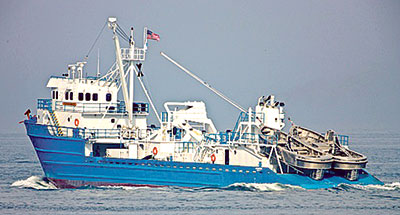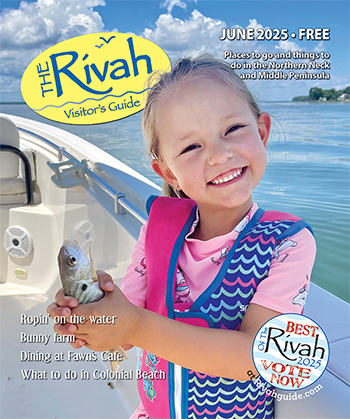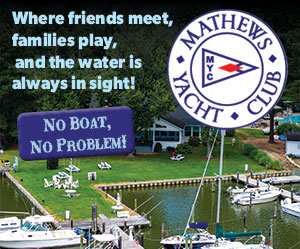In honor of 30 years of The Rivah Visitor’s Guide we are featuring stories that have previously been printed throughout our 30 year history. This feature story appeared in the August 2013 issue.

by Larry Chowning –

Amongst the crew, there was jubilant excitement, from dancing to jumping up and down with arms in the air, as the fish kept coming and coming.
“Yeah by God! They’re excited!” said Captain Lee Robbins. “They are making money!”
Robbins is captain of the Rappahannock, a new 196′ × 40′ Omega Protein fish steamer recently delivered to Reedville from Omega Shipyard Inc. in Moss Point, Mississippi.
The 184′ × 38′ Fleeton also was delivered recently by the company, and in May a christening of the two boats was held in Reedville that coincided with Omega Protein’s centennial celebrations, commemorating the company being chartered as Reedville Oil and Guano in 1913.
On Sunday, June 23, I spent a night on the steamer Rappahannock and witnessed a good day of fishing the following day when the crew caught over one million menhaden.
The Start
For menhaden fishermen, that Monday started at about 2:30 a.m. Almost everyone was bunked down until then. There are seven Omega boats fishing this season, and one by one first mates steered their boats away from the docks at the plant in Reedville and into the Chesapeake Bay.
At 2:45 a.m. there was a haze over the moon and a cool bay breeze blowing. All the other boats had white running lights but the Rappahannock had blue, giving it a mystical appearance on the water.

The boats followed each other into the Chesapeake Bay. Most of them headed toward Cape Charles on the Eastern Shore because there had been reports of fish in that area. Menhaden spotters in small planes had gone out Sunday to do some preliminary searching. Evidently there had been some noticeable “whips” up near Cape Charles. (Whips describes the color of the water above a school of menhaden.)
While the two Caterpillar 1,500-horsepower engines pushed the boat toward the fishing grounds, the crewmen worked at their duties.
Mealtime is 5 a.m. for breakfast, 10 a.m. for lunch and 3 p.m. for supper. The times are designed to work around fishing as best as possible. But, if fish are showing, mealtime might be anytime.
The Rappahannock’s cook, Kenny Pritchard of White Stone, has been a cook on menhaden vessels for 28 years. He was getting breakfast ready that day long before 5 a.m. He prepares the meals but also has responsibilities on deck when fishing starts.
At 5 a.m. the crew went into the comfortable galley/cafeteria for breakfast. The cook served scrambled and fried eggs, bacon and sausage, and it all tasted good.

The galley is conveniently designed with finished cabinets for storage above and below the white countertop. The electric cook stove has an aluminum brace bolted around the sides of the stove to keep the frying pan and pots from sliding off while in heavy seas. The crew eats cafeteria style and there is enough eating space to allow all crew members to eat at one time. There is a television in the cafeteria for the crew to view while they eat.
Members of the crew are mostly from the Northern Neck and Middle Peninsula and are all experienced fishermen, some with 20-plus years of experience. Most have followed in the footsteps of their fathers and grandfathers.
For a while, the boats stayed in the bay waiting for ebb tide, which is the best time to fish. At about 6 a.m. three spotter planes, one from Norfolk and two from Newport News, arrived on schedule. The Rappahannock was directly off Cheriton Bar near Cape Charles.
Fairly close were eight coal ships lined up and anchored waiting to be off-loaded in Norfolk. Captain Robbins, whose father Meredith also was a menhaden captain, said the coal ships usually anchor off Lynnhaven Inlet, but more and more have been anchoring in the bay off Cape Charles, awaiting entry to Norfolk.
Fishing had not been great this season. Robbins was discouraged as to how this day of fishing might go. “With a full moon, I don’t anticipate catching a lot of fish,” he said. “We usually catch more fish on the back side of a full moon.”
The cool and wet spring have been factors too. “We usually catch more fish when it’s real hot,” he said. “Bunkers (menhaden) like 90 degrees and a southwest wind for schooling up.”
There was anticipation that another night may have to be spent on the bay to get enough fish to warrant the trip.

The Catch
About 7 a.m., one of the three spotters radioed Robbins that there was a 450,000-500,000 school of fish coming his way, but there was a line of crab pots in the way. “There are plenty of fish but they are inside the pots,” the spotter said over the radio.
Robbins rang a bell to let the crew know they were to go to the purse boats. Nearly 20 minutes passed before the spotter told him the fish had moved away from the crab pots. Robbins gave the signal to go.
The Rappahannock had two purse boats positioned on the stern. When not in use, the purse boats are stored on the stern deck and are hydraulically lowered down, side by side, for the first setting of the nets. After the first set, the boats stay in the water until fishing is over for the day.
The purse boat platform on the stern has two “slides” slanted toward the water. There is one slide for each boat, built into the deck to keep the boats in place when on the steamer and when being lowered into the water. Each boat’s keel sets on a slide. There also are angled supports built on deck to keep the boats level while positioned on the platform. The Rappahannock’s platform is state-of-the-art. Most other Omega vessels use the age-old system of “davits” to carry the smaller boats. A davit is a small crane used to suspend and lower the purse boats. “It (slide system) is much safer and faster than davits,” said Monty Deihl, general manager of the Reedville plant.
Also, built on the sides of the steamer’s stern are two cat walks with rails that extend backwards toward the stern about 25 feet to about the center of each purse boat. This provides extra platform space for fishermen to stand on while waiting for the signal to go chase fish, and for them to get off and on the purse boats.

Robbins also is captain of one of the purse boats and oversees the fishing of the net. When Robbins goes to the purse boat, first mate Todd Rice, a veteran of 32 years, takes over the helm of the Rappahannock. There are three helmsman stations—one inside the pilothouse, one positioned over the work deck where fish are pumped into the steamer, and another, used specifically for docking, on the starboard side of the boat.
When fish are off-loaded, Rice is in charge of the big boat and works from the helmsman station that oversees where the boats off-load fish from the net. There are also two engineers on the boat who are responsible for maintenance of the assortment of engines, pumps and gears. The engineers also operate the hydraulics that run catheads, lower the purse boats down into the water, and the pumps that pump fish from the menhaden purse nets into the fish hold. Johnnie Haynie is first engineer and Glenn Delano is second engineer. Haynie and Delano are longtime Northern Neck names.
When going after fish, the two purse boats start out lashed together with a chain, each carrying half of the net. When fishing each purse boat splits away going in opposite directions and begins to make a semi-circle. In the process, both boats begin to release the net to encircle the fish. When the circle is complete and the purse boats are linked once again, a hydraulic winch or cathead (a hydraulic operated rope winder) is used to drop a 2,000-pound “tom” overboard. Made of lead, the tom slides down the purse line, both anchoring the end of the line and holding the net on the bottom. It also closes the net, preventing the escape of the encircled menhaden. With the purse closed, the tom is hauled up, and power blocks on both purse boats haul the net full of fish to the surface.
Power blocks are a modern invention that the industry started using about 1957. Prior to the power block age, it took a lot of hands to raise a net to the surface. The crew of the Rappahannock is composed of 15 crewmen, a total of 11 in the two purse boats, including the captain. There also are two engineers, a cook and the first mate who all stay on the big boat. Although power blocks do most of the work today, there is still a lot of pulling of net by hand that takes place. When getting the slack out of the net, the fishermen work hard to pull and haul the net by hand. Everybody seems to know exactly what their job is, and working together is paramount to a successful day of fishing.
Just inside Cape Charles Light, the boats made the set. The spotter had predicted 500,000 fish, a day’s work usually for the crew of the Rappahannock. He wasn’t far off as it was later determined to be a 450,000-fish catch.
As soon as the set was made, there was jubilation coming from the fishermen on the purse boats. After the power blocks on each purse boat corralled the fish, Rice brought the big boat up to the purse boats. The two purse boats, stern to ship, formed a vee against the side of the steamer as fishermen continued to tighten the net. The first mate, cook and two engineers worked from the deck of the Rappahannock, while everyone else remained in the purse boats. The cook threw and caught ropes, engineers operated the hydraulics, and all three worked to secure the ship’s side of the net to a railing. With the nets up against the two purse boats and the steamer, the net full of fish was secure.
Using the mast/boom on the ship, hydraulics were used to raise excess net overhead and a 12-inch diameter black hose was dropped into the mass of captured fish and water. Fish and sea water are pumped from the net together through the large hose and are deposited on a dewatering screen, which separates the water from the fish. The warm sea water is directed overboard on the opposite side from where the net is being unloaded. Seagulls flock to the warm white-foam sea water, picking up whatever fish elements are there.
The fish are directed into a shoot where they slide down into the refrigerated fish holds. As the fish fall into the holds, one to two thousand gallons of sea water chilled to 32-36 degrees is pumped into the hold to keep the fish fresh. The cold sea water is sprayed over the top of the fish as the menhaden slide down into the hold. The Rappahannock has twice the refrigerated hold capacity as most other Omega boats. Robbins estimated it can safely hold 2 million fish.

In about 45 minutes, the set was complete and about 450,000 menhaden were secured into the Rappahannock’s fish hold. When the catch was landed, Robbins went back up into the pilothouse to await another school of fish. “Well, you won’t have to worry about spending another night on this boat,” he said to me. “We just caught a day’s work. Everything else will be gravy.”
At 10 a.m. the crew went for lunch. They had vegetable beef soup and grilled cheese sandwiches. Just as everyone was about to relax, the spotter indicated there was another set closeby—maybe 250,000 fish. He was close and that set brought the day’s catch upward to 700,000 fish. The first mate said he estimates the number of fish by keeping track of the amount of time it takes to catch and off-load.
About noon, everything got quiet. Robbins reflected that “when there are no signs of fish, I tend to fish on my feelings.”
When there is more than one fish steamer working the same area, the boat closest to a school gets first fishing rights.
Robbins pushed ahead with little direction from the spotters. Suddenly, the spotter said there was a school ahead. It was a small school, so small that the mast was not needed to hoist up the net rigging. “We call this a drive-by when we don’t have to hoist the net up in the air,” said Robbins. However, the crew appeared to work just as hard for a small set as they did for a large set.
A good day
The crew always seemed in good spirits, even while enduring such back-breaking work. Each fisherman had a job and knew exactly what to do.
There was some trouble on the boat with refrigeration in one of the fish holds and this concerned the captain and engineers. “We’ve got all these fish and I’m not going to let them spoil,” said Robbins.
After a total of five sets that day, the crew of the Rappahannock had landed an estimated 1.2 million fish. Using his radio, Robbins informed the dock at Reedville he was having refrigeration problems and needed to be one of the first at the dock to off-load. This was around 2 p.m. and he was told that the dock would not start off-loading fish until 3 p.m., but that he had first docking rights.
When the boat got back to the Reedville plant, I was packed and ready to get off. Captain Robbins told me, “Let me tell you something—you brought us good luck. You come back any time.”
The crew, captain, mate and engineers are all paid by Omega by the number of fish they catch. That Monday was a good payday for all!





